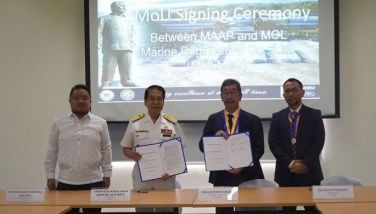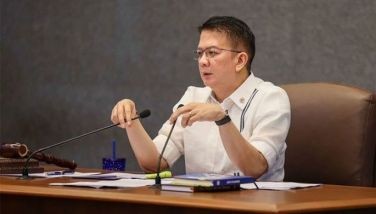Government declares holiday ceasefire with NPA, MILF
December 2, 2000 | 12:00am
The government has unilaterally declared a ceasefire with the communist New People’s Army (NPA) and the secessionist Moro Islamic Liberation Front (MILF).
Defense Secretary Orlando Mercado said the suspension of military offensive (SOMO) against the NPA, declared in the spirit of Christmas, will start on Dec. 16. The ceasefire with the MILF, on the other hand, took effect yesterday. Both SOMOs will end on Jan. 9.
Mercado told reporters that the truce with the MILF was primarily in deference to the Muslims’ observance of the holy month of Ramadan which began on Nov. 27.
"Since we have reiterated our willingness to resume peace talks with the MILF, it (SOMO) will be an important confidence-building measure," Mercado stated in a memorandum to President Estrada.
"It will also allow MILF rebels and supporters to contribute to the rebuilding of those communities in Central Mindanao and elsewhere that were affected by the recent conflict," he added.
On the other hand, the SOMO with the NPA was merely a repetition of the same truce last year in the spirit of the holiday season.
"This will allow NPA rebels to consider the possibility of abandoning their armed struggle as well as provide for a humanitarian pause in this conflict," Mercado said.
The secretary claimed there were two "rejectionist" factions within the NPA, the Revolutionary Proletariat Army (RPA) and the Rebolusyonaryong Hukbong Bayan (RHB). Both reportedly operate mainly in the Negros-Panay and Central Luzon areas.
Mercado said peace talks with the RPA were ongoing, with Agriculture Secretary Edgardo Angara heading the government panel.
In the case of the RHB, Mercado said there appeared no definite leader who can talk with the government panel.
Mercado said the government can explore the possibility of initiating peace talks with the rebels "if a climate of peace, even just pursuant to a ceasefire, is created."
He said the government is not thinking of any ceasefire with the extremist Abu Sayyaf rebels.
The NPA is the military arm of the Communist Party of the Philippines which has been waging a political and armed struggle against the government over the past three decades.
For its part, the MILF, a breakaway faction of the mainstream Moro National Liberation Front (MNLF), is fighting for an independent Islamic state in Mindanao.
The MNLF forged a peace agreement with the government in September 1998.
The military placed the current strength of the MILF at less than 10,000 armed regulars.
Soldiers captured 13 major camps and 33 satellite camps of the Muslim rebel group in Central Mindanao during a four-month relentless campaign launch last April.
Despite the offensive, peace negotiations with the MILF continued until the rebels decided to withdraw from the talks in August citing as reason alleged government insincerity in bringing an end to the civil strife in the South.
The following month, the President issued Proclamation 390 offering amnesty to the MILF rebels even as he ordered unconditional resumption of the peace talks.
The NPA’s strength peaked in 1986 with 25,000 guerrillas, but the number gradually declined through the years, dropping to a low of 8,000 fighters in 1997.
However, military intelligence indicated that the NPA intensified anew its recruitment activities and was able to expand its strength to 10,000 men with 6,000 firearms.
Authorities attributed the increase to the prevailing economic crisis.
Defense Secretary Orlando Mercado said the suspension of military offensive (SOMO) against the NPA, declared in the spirit of Christmas, will start on Dec. 16. The ceasefire with the MILF, on the other hand, took effect yesterday. Both SOMOs will end on Jan. 9.
Mercado told reporters that the truce with the MILF was primarily in deference to the Muslims’ observance of the holy month of Ramadan which began on Nov. 27.
"Since we have reiterated our willingness to resume peace talks with the MILF, it (SOMO) will be an important confidence-building measure," Mercado stated in a memorandum to President Estrada.
"It will also allow MILF rebels and supporters to contribute to the rebuilding of those communities in Central Mindanao and elsewhere that were affected by the recent conflict," he added.
On the other hand, the SOMO with the NPA was merely a repetition of the same truce last year in the spirit of the holiday season.
"This will allow NPA rebels to consider the possibility of abandoning their armed struggle as well as provide for a humanitarian pause in this conflict," Mercado said.
The secretary claimed there were two "rejectionist" factions within the NPA, the Revolutionary Proletariat Army (RPA) and the Rebolusyonaryong Hukbong Bayan (RHB). Both reportedly operate mainly in the Negros-Panay and Central Luzon areas.
Mercado said peace talks with the RPA were ongoing, with Agriculture Secretary Edgardo Angara heading the government panel.
In the case of the RHB, Mercado said there appeared no definite leader who can talk with the government panel.
Mercado said the government can explore the possibility of initiating peace talks with the rebels "if a climate of peace, even just pursuant to a ceasefire, is created."
He said the government is not thinking of any ceasefire with the extremist Abu Sayyaf rebels.
The NPA is the military arm of the Communist Party of the Philippines which has been waging a political and armed struggle against the government over the past three decades.
For its part, the MILF, a breakaway faction of the mainstream Moro National Liberation Front (MNLF), is fighting for an independent Islamic state in Mindanao.
The MNLF forged a peace agreement with the government in September 1998.
The military placed the current strength of the MILF at less than 10,000 armed regulars.
Soldiers captured 13 major camps and 33 satellite camps of the Muslim rebel group in Central Mindanao during a four-month relentless campaign launch last April.
Despite the offensive, peace negotiations with the MILF continued until the rebels decided to withdraw from the talks in August citing as reason alleged government insincerity in bringing an end to the civil strife in the South.
The following month, the President issued Proclamation 390 offering amnesty to the MILF rebels even as he ordered unconditional resumption of the peace talks.
The NPA’s strength peaked in 1986 with 25,000 guerrillas, but the number gradually declined through the years, dropping to a low of 8,000 fighters in 1997.
However, military intelligence indicated that the NPA intensified anew its recruitment activities and was able to expand its strength to 10,000 men with 6,000 firearms.
Authorities attributed the increase to the prevailing economic crisis.
BrandSpace Articles
<
>
- Latest
- Trending
Trending
Latest
Trending
Latest
Recommended
February 20, 2025 - 12:00am



























